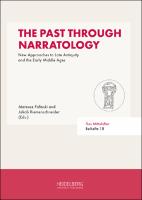The Past Through Narratology
Single-Blind-Peer-Review overseen by Series Editor
New Approaches to Late Antiquity and the Early Middle Ages
| dc.contributor.editor | Fafinski, Mateusz | |
| dc.contributor.editor | Riemenschneider, Jakob | |
| dc.date.accessioned | 2022-05-23T10:22:04Z | |
| dc.date.available | 2022-05-23T10:22:04Z | |
| dc.date.issued | 2022 | |
| dc.identifier | OCN: 1342561157 | |
| dc.identifier.uri | https://library.oapen.org/handle/20.500.12657/54668 | |
| dc.description.abstract | „The Past through Narratology“ proposes a fresh approach to various types of texts from Late Antiquity and the Early Middle Ages. Starting from a broad definition of what a text can be – ranging from hagiographic narratives and maps to archaeological remains – this book proposes narrativity and narratology as frameworks for exploring sources and exchanging opinions. The various contributions in this volume investigate how late antique and early medieval authors and movements used narrative as a vehicle for their ideas and how they operated in literarised spaces. At the same time, this book also examines how we as researchers construct narratives about our periods of study. | en_US |
| dc.language | English | en_US |
| dc.relation.ispartofseries | Das Mittelalter. Perspektiven mediävistischer Forschung. Beihefte | en_US |
| dc.subject.other | Late Antiquity, Early Middle Ages, Narratology, Narrativity, Historiography, Spätantike, Frühmittelalter, Narratologie, Narrativität, Historiographie | en_US |
| dc.title | The Past Through Narratology | en_US |
| dc.title.alternative | New Approaches to Late Antiquity and the Early Middle Ages | en_US |
| dc.type | book | |
| oapen.abstract.otherlanguage | „The Past through Narratology“ bietet neue Ansätze zur Interpretation spätantiker und frühmittelalterlicher Texte. Ausgehend von einer weit gefassten Definition dessen, was ein Text sein kann – von hagiographischen Erzählungen über Karten bis hin zu archäologischen Überresten –, schlägt dieses Buch Narrativität und Narratologie als Deutungsrahmen für die Erforschung von Quellen und den wissenschaftlichen Austausch neuer Ideen vor. In den hier versammelten Beiträgen wird untersucht, wie Autoren und literarische Bewegungen Sinnzusammenhänge in Erzählform brachten und sie in literarisierten Räumen positionierten. Gleichzeitig stellen sie die Frage, wie wir als Forscher Narrative über unsere Vergangenheit konstruieren. | en_US |
| oapen.identifier.doi | 10.17885/heiup.921 | |
| oapen.relation.isPublishedBy | e783d080-4414-442b-9d7e-07b750c7b25d | en_US |
| oapen.relation.isbn | 9783968221076 | en_US |
| oapen.collection | AG Universitätsverlage | |
| oapen.imprint | heiUP | en_US |
| oapen.series.number | 18 | en_US |
| oapen.pages | 248 | en_US |
| oapen.place.publication | Heidelberg | en_US |
| peerreview.anonymity | Double-anonymised | |
| peerreview.id | e07c6bc8-0969-4c86-a485-6058c2347467 | |
| peerreview.open.review | No | |
| peerreview.publish.responsibility | Books or series editor | |
| peerreview.review.stage | Pre-publication | |
| peerreview.review.type | Full text | |
| peerreview.reviewer.type | External peer reviewer | |
| peerreview.title | Single-Blind-Peer-Review overseen by Series Editor |

